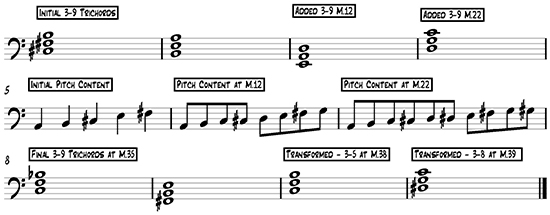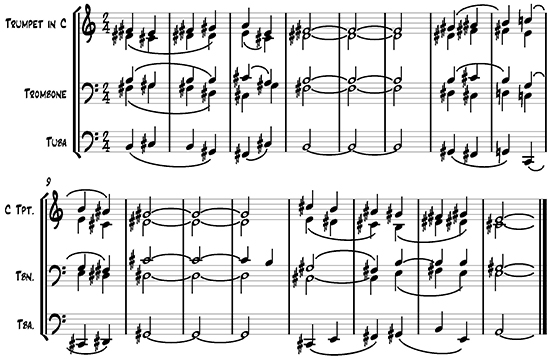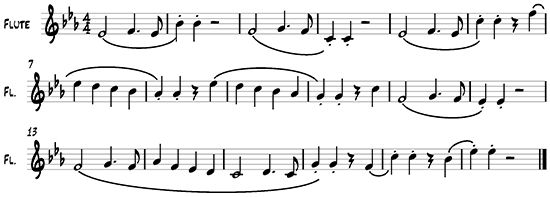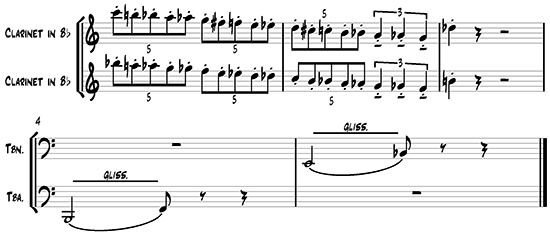Appendix
Chicago Symphony Orchestra, directed by Fritz Reiner
Since this[1] is not primarily an analytic essay, the discussion will be extremely limited. What follows is a loosely set - theoretic approach to a fragment of the opening.
As was the case with numerous late eighteenth century symphonic works (Haydn’s symphonies come to mind), the first movement of the Concerto for Orchestra begins with a slow introduction. The initial material is presented by the ‘celli and double basses.

The pitch material can be reduced to two “chords” formed from conjoined perfect fourths. These are common enough structures and have been named in various analytic systems, either as segments of a cyclic set (George Perle’s terminology, where a set either as ordered or unordered is generated from a single interval or pair of intervals)[2] or as 3-9 trichords (Forte’s set theory). For convenience, I have adopted the latter terminology. The following illustrates the gradual incorporation of additional pitch material.

The skeletal presentation does not suggest the process by which Bartók expands the pitch content. The material expands through developing variation, with them gradually accommodating the additional 3-9 trichords. The first addition appears at measure 12.

The next expansion of the theme appears at measure 22. At this point, Bartók has incorporated ten of the twelve notes of the aggregate pitch collection into the theme (F natural and B flat are absent).

The opening of the passage suggests a process of liquidation, the dissolution of shaped material into non-characteristic material. In this case, the initial 3-9 trichords are presented as a segment of a circle of fifths, rhythmic motives are reduced to chains of quarter notes. The final presentation at measure 35 completes the twelve-tone aggregate.

At the fourth measure of the excerpt, Bartók, having already liquidated the rhythmic patterns into a stream of eighth notes, begins the transformation of the characteristic 3-9 into related variants, the perfect fourths of the opening become part of pattern that recedes into an accompanying figure.
My hybrid analysis, with its conflation of some elementary set theory with Schoenberg’s terminology of motivic development, is intended to underscore the competing elements in Bartók’s composition – the combination of non-traditional, primarily quartal figures with an extension of a derived process of developing variation and subsequent liquidation of motivic material. The link is one made by Schoenberg in regard to his own composition, where the new pitch language is linked to (and justified by) participation in a tradition of formal structure and developing variation. The ties to absolute music are made explicitly in Schoenberg’s 1947 article, “Brahms the Progressive.”
It is the purpose of this essay to prove that Brahms, the classicist, the academician, was a great innovator in the realm of musical language, that, in fact, he was a great progressive.[3]
While Bartók’s (and for that matter Schoenberg’s) final works reflect the traditions of absolute music, his earlier works are rooted in the traditions of program music. In part, the compositional procedures detailed above are the end product of Bartók’s rejection of earlier models of composition. Bartók’s most overtly political work is his early tone poem, Kossuth of 1902. Benjamin Suchoff cites Bartók’s quotation of “Gott erhalte Franz den Kaiser” in Kossuth.[4]
Bartók provided a detailed program for the work, describing the work as having “ten closely related sections, each with an epigraphic inscription.”[5] Each section of the text is connected a to a specific theme. For example, Bartók denotes the theme from the seventh section, “’Come, oh come, ye haughty warriors, ye valiant heroes!’ –Kossuth’s summons to the Hungarian nation to fly to arms” as the “Hero Theme.”[6]

The “Kaiser Hymn” appears in the next section, “Then is heard the sound of the enemy’s host, approaching nearer and nearer.”

In both its episodic structure and its reliance on extra-musical associations, Kossuth is clearly a work that follows in the tradition of Wagner and Strauss, models Bartók would later reject. Curiously, in its subject matter and treatment of an “alien” melody, the work foreshadows Shostakovich’s Seventh Symphony, with the Kaiser Hymn serving as an invasion theme.
Bartók’s quotation of the Kaiser Hymn in program music is an overt political gesture, the melody serving as national flag born by a figure in painting of a battle scene. This assertion is warranted on three counts. First, the melody is quoted verbatim. Second, the melody had (and retains) immediate associations for the intended audience. Third, the program makes intention concrete. What happens when quotation is less overt, or when elements with political or national meaning have been abstracted? The appearance of a French or American flag carried by a figure in a painting is obvious enough, but what of a painting that reduces its palette to red, white, and blue?
Research and occasional written statements by the composer establish that Bartók continued to reference extant melodies in his work. However in the works written after Kossuth, the source and nature of that reference changed. Bartók used his ethnomusicological research as source material, and the appearance of Eastern European melodies has been noted in the Concerto for Orchestra. Bartók became less inclined to offer literal quotation, but instead derived themes from extant melodies, or borrowed elements of melodic and rhythmic practice. As the titles of the works became abstract, Music for Strings Percussion and Celeste or Concerto for Orchestra, Bartók ceased to offer programmatic explanations, and it becomes more difficult to recognize, interpret, and even make an assumption that Bartók intended the quotation to be recognized.
Here is an example from the Concerto for the Orchestra. Though Bartók’s personal religious beliefs have been the subject of some debate, the Unitarian Universalist Church claims Bartók as a congregant. The biography posted on the UUA website plays an excerpt from the Concerto for Orchestra’s second movement, the “Game of Pairs.” The title, though not relevant to this particular section, refers to the movement’s structure. A three-part form, the “A” section features pairs of instruments presenting successive themes. This excerpt, played by brass choir, is usually denoted as the “B,” or the central section of a three-part form.

The passage is “chorale-like.” Bartók’s melodic line does not quote a specific hymn melody, but through its conjunct motion evokes the style of hymn melodies. At the same time, the excerpt does not fully comply with conventions of voice-leading or functional harmony. The chorale is written in five voices rather than the traditional four. The harmony is tertian (the prolonged 3-9 trichord at measure 10 in the excerpt functions as a conventional 4-3 suspension) as it would be in a chorale, rather than quartal. In short, a sufficient range of stylistic features suggests that Bartók is referring to a chorale without literal quotation.
In Benjamin Suchoff’s monograph, the appearance of the chorale “verifies the apparent pastoral program of the movement. The preceding ‘Sunday order of dances’–a feature of village life that Bartók observed during his field trips to collect Romanian folk music–is interrupted by a chorale-tune imitation in the brass, as if the scene switches to the interior of a rural church.”[7] This interpretation might not have occurred to Bartók’s fellow congregants at the Unitarian Church of All Souls on New York’s Upper Eastside, or to the authors of the website. While one may recognize the general reference to a chorale, Bartók’s exact meaning (assuming there was one) remains a matter of conjecture.
The main issue of cross-reference in the Concerto for Orchestra is the possible link to Shostakovich’s Seventh Symphony. The third theme of Shostakovich’s opening movement has been dubbed the “invasion” theme. The quotation below is actually the theme’s second iteration. The theme is played first in the strings, but the skeletal rhythmic presentation renders comparison to Bartók’s “quotation” less obvious. This form, with the notes sustained, is the presentation Shostakovich repeats.

Here is the theme from the “Interruption” of the fourth movement. [Note that the part appears in transposition, the pitch content is of course the same in both pieces, save for Bartók’s triplets.]

The question is, is this quotation? The opening motive of Shostakovich’s theme is missing, and the remainder of the theme is not sharply profiled, being nothing more than a descent through a scale segment. Suchoff registers the theme as such: “The parodic treatment of the Shostakovich theme, in the same key of E flat major as the source melody, begins in the first clarinet.[8]
The conductor Antal Dorati recounted a conversation with Bartók that links the Concerto to Shostakovich’s Symphony. In a 1981 article, “Bartokiana (Some Recollections),” Antal Dorati wrote:
“Once when we were alone, Bartók asked me: ‘Do you know what the interruption in the ‘Intermezzo Interrotto’ is?’
‘Of course I do, Professor,’
‘Well?’
‘It is a quote from The Merry Widow.’
‘And who is that?’
Momentarily nonplussed, I then established that he did, after all, know who Lehár was, and had heard of The Merry Widow. But because the music was quite unfamiliar to him, and had no conceivable bearing on what he had been thinking, he had not grasped what I was referring to.
So, evidently, it was not a quote from there. What was it, then? Having extracted my solemn promise that I would not tell anyone while he was still alive–oh, that the secret could have been kept far longer–he confided that he was caricaturing a tune from Shostakovich’s Seventh Symphony, the Leningrad, which was then enjoying great popularity in America, and in Bartók’s view, more than it merited. ‘So I gave vent to my anger,’ he said.”[9]
Another conductor, Ferenc Fricsay, in a short work titled Über Mozart und Bartok, provided the competing explanation, reporting a conversation between Bartók and pianist György Sandor.[10] The translation is David Cooper’s.
“A young lover, an idealist, brings his beloved a serenade, which, after the introduction flows through a great viola cantilena, which is then taken over by the violins. The hidden meaning is this: the serenader personifies a nation, and the ideal to which he sings is his fatherland. This great cantilena is known throughout Hungary by every child, in fact it was made famous by a fairy-tale operetta.
At this moment a drunken mob comes by – with fifes, trumpets, and drums – interrupting the idealist just as he’s singing his most beautiful song. The brutal destoyer of this scene reveals himself to be a boot-boy, a rough possessor of power, who leaves ruin and waste behind him where he goes: he whistles a trivial melody, a gutter-song which has considerable similarity to a Lehár melody.
Bartók subsequently told Sándor that the boot symbolizes the garrison’s power, which, while one is engaged in more idealistic matters, leaves terrible trails of domination and violence in its wake. Indeed one can hear the drunk throwing up depicted by the tuba. Three merciless punches from the cymbals and a blow with a rifle-butt–all is quiet.”[11]
The second explanation is the first to suggest some political intentions on Bartók’s part, the first seemingly remains an aesthetic judgment of distate for Shostakovich’s work. Obviously the two explanations, along with their respective attributions, conflict. Even the significance of the descending clarinet and brass glissandi is interpreted differently, in one case mocking the composer , in the other mocking the protagonist (who, according to Sándor, vomits after the attack depicted by the glissandi in tuba and trombones).

The stories gained currency. Without a definitive statement by the composer, the differing interpretations have become intermingled, either knowingly or carelessly (as in a current music textbook which conflates elements of Fricsay and Dorati’s accounts). One solution is to accept the melody as resembling both Lehár’s and Shostakovich’s themes. David Cooper has given this double reference to the melody, stating that the melody “burlesques both the march theme from Shostakovich’s Seventh Symphony and the aria ‘Da geh’ ich zu Maxim’ from Hungarian operetta composer Lehár’s Die lustige Witwe.”[12] Since both attributions might be regarded as hearsay, it is as if Cooper hedges his bet.
The other sources for Bartók’s Concerto for Orchestra are Hungarian and other Eastern European folksongs, either pieces the composer collected himself or borrowed from common sources, a reference suggested for another theme from the Concerto’s fourth movement. Bartók was candid about his use of folk material, frequently discussing his practice of collecting and making use of specific melodies as well as his use of more abstracted elements of pitch and music, but he insisted that he transformed the material. On the strictest view of absolute music, one that insisted open an “organic” generation of material from motive invented by the composer, these borrowings could be viewed as external influences on music. In the discussion of Bartók’s music, most commentators have accepted Bartók’s explanation and conceded that Bartók assimilated these borrowings into his personal musical language. Again, the question is one of originality. As stern a critic as Theodor Adorno found Bartók’s use of folk material acceptable as demonstrated in his 1929 review of the Third String Quartet.[13]
Bartok’s development is oriented exclusively toward three movements, movement models, as it were, which are never quite allowed to dissolve. Their ideas have been ignited by the blast of European musical consciousness striking the still-glowing embers of Hungarian folklore, whose genuineness Bartók legitimizes once more by accepting the European attack rather than retreating into romantic security.
In this view, the fourth movement considered schematically, integrates Hungarian “folk” material into a structure reminiscent of a classical rondo form. This is not an original observation on my part, but one common to the discussion of the movement (Suchoff terms it a reworking of a “Beethovenian rondo form) and suggested by Bartók’s own commentary.[14] The “A” theme alternates groups of four and five (what is usually termed additive rhythm). The theme is unambiguously tonal (and like the material previously illustrated from the first movement), deploys developing variation based on the initial cell.

In a device familiar for much of Western musical history, Bartók presents the theme in inversion as well (all instruments at concert pitch).

The large “A” section can be represented as comprising four large phrases: two statements of the initial phrase, a statement of the inversion, a reprise of the initial phrase.
The contrasting “B” section presents a theme often regarded as a paraphrase of “You are lovely, you are beautiful, Hungary” from an operetta by Zsigmond Vincze.[15]

As it appears in Bartók’s work, obviously extensively reworked:

After the “B” section, Bartók returns to the “A” section. In a traditional rondo, this return would reprise the formal patterning of the “A” section as well as the thematic material. The interruption with the “Shostakovich/Lehár” theme is an interruption of an expected structural moment as well as presentation of a theme that is alien to its surroundings, in that its pitch content and rhythmic profile, in contrast to the material generated by developing variation used previously in the movement, does not derive from the motivic material that has already appeared in the work.
The theme of the “C” is subject to the same transformations apparent in the rest of the Concerto for Orchestra. The descending pattern is liquidated into non-characteristic material. This pattern, analytically regarded as part of the compositional process, has been given a variety of programmatic interpretations (laughing at Shostakovich, or being assaulted by a street tough).

The theme is subject to inversion as well:

The “rondo” form is incomplete. In a traditional rondo, the “A” section would reappear. Instead, the movement closes with a partial return of first the “B’ and then the “A” theme. The “A” theme is not fully reprised, but contains a brief cadenza for flute (a reference to the tradition of the concerto). The overall structure of the movement is a hybrid, or reworking of a textbook form, a progressive (in Schoenberg’s sense) use of the tradition.
[1] Music, Politics and the Imagination: Béla Bartók’s Concerto for Orchestra
[2] Common musical structures can be considered this way, i.e. a fully diminished seventh chord is generated by the interval of a minor third, an octatonic scale from the alternation of major and minor seconds.
[3] Arnold Schoenberg, “Brahms the Progressive,” in Style and Idea, edited Leonard Stein (London: Faber and Faber, 1975), 401.
[4] Benjamin Suchoff, Bartók: Concerto for Orchestra, 25-27.
[5] Béla Bartók, “Kossuth Symphonic Poem,” in Suchoff, Benjamin (ed.), Béla Bartók Essays, 399.
[6] ibid, 401-402.
[7] Benjamin Suchoff: Bartók: Concerto for Orchestra – Understanding Bartók’s World, (New York: Schirmer Books, 1995), 141.
[8] Benjamin Suchoff, 163.
[9] Antal Dorati, “Bartokiana (Some Recollections),” Tempo, No. 136 (March, 1981), 12.
[10] Ferenc Fricsay, Über Mozart und Bartok, (Copenhagen: Edition Wilhelm Hansen, 1961): 59-60.
[11] David Cooper Bartók: Concerto for Orchestra, (Cambridge, Cambridge University Press: 1996), 56.
[12] David Cooper, Bartók: Concerto for Orchestra, (Cambridge, Cambridge University Press: 1996), 57.
[13] In Bartok and his World, 278
[14] Suchoff, 151.
[15] David Cooper, 56. The same song is cited, without specific source in an introductory music text, The Enjoyment of Music.
Literature:
See main article.










